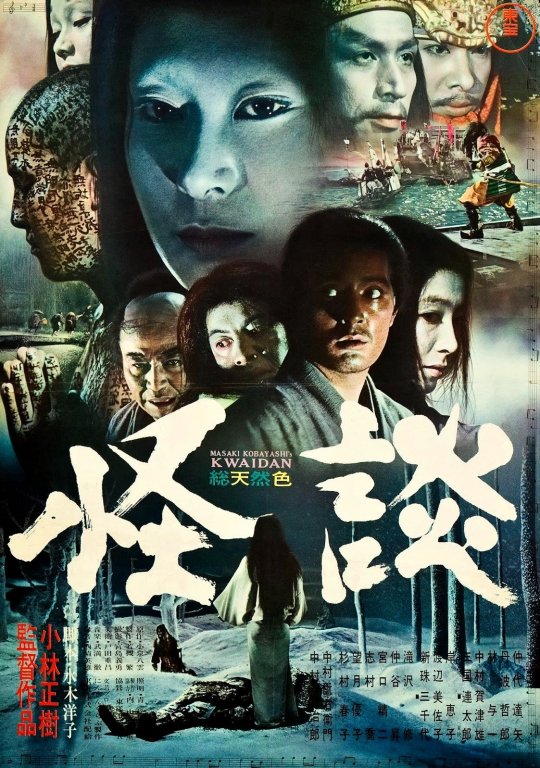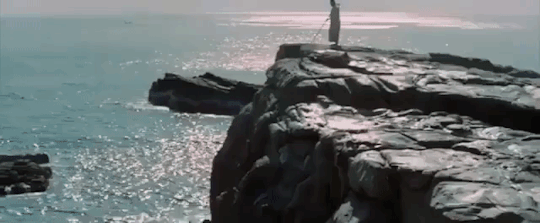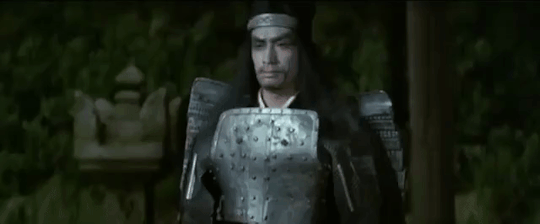#yoichi hayashi
Explore tagged Tumblr posts
Text

Meiko Kaji (梶芽衣子) and Yoichi Hayashi (林與一) in Ghost Story Of Dakki No Ohyaku (怪談!妲己のお百), 1987.
Meiko plays a woman possessed by the spirit of an Umibozu yokai.
29 notes
·
View notes
Text
Horror Movie of the day: Kwaidan (1964)
What are ghosts? How do they manifest when show up? It could be in the guilt of a samurai, who left his wife in order to advance his position by remarrying to the daughter of an important family only to try and come back to his lost love. It could be a woodcutter's fear after surviving an encounter with the Yuki Onna, woman of snow, in the condition he keeps this encounter to himself. Maybe it's in the strange aura the Emperor has when asking a blind musician to perform for him in an univiting court. Or maybe, they could be found in the distorted reflection a warrior sees in his cup of tea. These are the stories from the beyond.
Directed by Masaki Kobayashi and based on a collection of traditional stories compilled by Lafcadio Hearn, this is arguably still the ultimate ghost anthology to ever come out of Japan. It quite intelligently favors the psychological angle for the characters who experience the stories, which enhances the illogic and fright of the supernatural terrors they face while also landing them exquisite thematic depth. It's a set of four separate strong scripts that could survive even with lesser visuals.
That isn't to say the movie isn't a visual treat, however. With a lavish production design, it isn't afraid of playing loose with the visual realism where it finds it fitting, using fairly obvious but strongly expressionistic set designs where the backgrounds are clearly painted. And since all these are traditional folkloric stories, this aesthetic qurik lends them a theatre-like quality as if you were watching a Noh play, while also having some absolutely STELLAR cinematography and a breathtaking color palette that fits the mood of each story.
It's on the long end with a little over three hours of runtime, but this just means every story gets it's proper due and it's all the more worthy for it. This isn't just a horror classic, it's an absolute must watch for any enthusiast of the art of cinema.

#horror movies#halloween movie#japanese folklore#j horror#japanese cinema#masaki kobayashi#yoko mizuki#tatsuya nakadai#rentaro mikumi#tersuro tamba#keiko kishi#michiyo aratama#misako watanabe#yoichi hayashi#katsuo nakamura#takashi shimura#osamu takizawa#nakamura ganjiro ii#haruko sugimura#toru takemitsu#kwaidan#roskirambles
7 notes
·
View notes
Text

#Kwaidan#Tatsuya Nakadai#Rentarō Mikuni#Tetsurō Tamba#Keiko Kishi#Michiyo Aratama#Misako Watanabe#Yoichi Hayashi#Katsuo Nakamura#Osamu Takizawa#Haruko Sugimura#Nakamura Kan'emon#Nakamura Ganjirō II#Masaki Kobayashi#1964
30 notes
·
View notes
Text

if this doesn't make you cry, i don't know what will.
3 notes
·
View notes
Text

#Lollipop Tonic featuring K#yoichi hayashi#hisako agatsuma#ayako masuda#グルーブロック#GROOVE ROCK#bemani#pop'n stage#pop'n music#konami
2 notes
·
View notes
Text
LONE WOLF AND CUB: BABY CART IN PERIL
Hunt tattooed lady
Boy gets lost with performers
Rival seeks vengeance
youtube
#lone wolf and cub#baby cart in peril#random richards#poem#haiku#poetry#haiku poem#poets on tumblr#haiku poetry#haiku form#criterion collection#criterion channel#ogami itto#tomisaburo Wakayama#Yoichi Hayashi#Michi Azusa#Akihiro Tomikawa#buichi saito#Kazuo Koike#Goseki Kojima#Youtube
0 notes
Text
Celebrating episode 300, your deadicated hosts travel to Japan for Nobuo Nakagawa's masterpiece JIGOKU (1960)! The film stars Shigeru Amachi, Yoichi Numata and Utako Mitsuya.
Your hosts discuss nihilism, Buddhism, gore and more in this landmark episode.
Context setting 00:00; Synopsis 36:08; Discussion 49:48; Ranking 1:22:57
#podcast#horror#japanese horror#japanese gore#nobuo nakagawa#shintoho#jigoku#buddhism#the sinners of hell#shigeru amachi#yoichi numata#utako mitsuya#hiroshi izumida#kiyoko tsuji#akiko ono#hiroshi hayashi#kimie tokudaij#jun otomo#mitsugu okura#ichiro miyagawa#mamoru morita#toshio goto#chumei watanabe#faust#SoundCloud
12 notes
·
View notes
Text

#ProyeccionDeVida
🎬 “EL CIRCULO” [The Ring / Ringu]
🔎 Género: Terror / Intriga / Tecnológico / Sobrenatural / Fantasmas / Película de Culto / J-Horror

⌛️ Duración: 91 minutos
✍️ Guión: Hiroshi Takahashi
📓 Novela: Kôji Suzuki
♫ Música: Kenji Kawai
📷 Fotografía: Junichirô Hayashi

🗯 Argumento: En una pequeña y apacible localidad japonesa, entre los estudiantes circula una leyenda en torno a unos videos malditos cuya visión provoca la muerte. Tras la muerte de su sobrina Tomoko, una periodista, Reiko, investigará el origen de dichos videos.
👥 Reparto: Nanako Matsushima (Reiko Asakawa), Hiroyuki Sanada (Ryuji Takayama), Rie Inō (Sadako Yamamura), Miki Nakatani (Mai Takano), Yūko Takeuchi (Tomoko Oishi), Rikiya Ōtaka (Yoichi Asakawa), Hitomi Satō (Masami), Takashi Takayama (Takehiko Nomi) y Yutaka Matsushige (Yoshino).

📢 Dirección: Hideo Nakata
© Productoras: Kadokawa Shoten & Omega Project
🌎 País: Japón
📅 Año: 1998

📽 Proyección:
📆 Martes 22 de Octubre
🕗 8:00pm.
🎦 Cine Caleta (calle Aurelio de Souza 225 - Barranco)
🚶♀️🚶♂️ Ingreso libre

🙂 A tener en cuenta: Prohibido el ingreso de bebidas y comidas. 🌳💚🌻🌛
0 notes
Text

Ring (Hideo Nakata, 1998)
Cast: Nanako Matsushima, Hiroyuki Sanada, Rikiya Otaka, Miki Nakatani, Yuko Takeuchi, Hitomi Sato, Daisuke Ban, Rie Ino, Masako, Yoichi Numata, Yutaka Matsushige, Katsumi Muramatsu. Screenplay: Hiroshi Takahashi, based on a novel by Koji Suzuki. Cinematography: Jun'ichiro Hayashi. Production design: Iwao Saito. Film editing: Noboyuki Takahashi. Music: Kenji Kawai.
Hideo Nakata's Ring is a film with nicely creepy images and a neat premise that imbues modern technology with ancient dread: an ordinary and (at the time) familiar item like a videocassette that carries a deadly curse giving its victim a few days of torture and fear. The supernatural by definition has no rules, so the best anyone investigating a supernatural occurrence like a haunted videotape can do is find out what's causing it, which constitutes the film's plot. Of course, it helps if the investigator has supernatural powers like extrasensory perception, which is why I think the screenplay cheats a little, depriving the film of some of the suspense it would have had if the tape's victims had less of an advantage.
0 notes
Text
March 13, 2021: Kwaidan: Hoichi the Earless (1965)
Um...yeah, no idea, people.

Not sure what “the earless” means, but it worries me. So, rather than try to guess here, let’s get right into it!
This is the third of four tales presented in the film Kwaidan, listed here:
The Black Hair (黒髪, Kurokami)
The Woman of the Snow (雪女, Yukionna)
Hoichi the Earless (耳無し芳一の話, Miminashi Hōichi no Hanashi)
In A Cup of Tea (茶碗の中, Chawan no Naka)
Here we go again! SPOILERS AHEAD!!!
Recap (3/4): Hoichi the Earless

A musician sings a song, known as “The Tale of the Heike”, and is specifically detailing the epic Battle of Dan-no-ura, during which two clans fought each other at the end of a great war. The scene is played out on screen as kabuki theatre, with the singer strumming an instrument in the background of the epic clash. It’s, uh...it’s pretty goddamn rad, not gonna lie to you.
Don’t know if you guys have ever seen kabuki theater, like legit kabuki theater, but it’s genuinely interesting. If you want to see an example accessible to non-Japanese audiences (and nerds like me everywhere), check out Star Wars Kabuki-Kairennosuke and the Three Shining Swords! Here’s a link! It is also rad.

Anyway, the epic tale of war and suicide results in a haunted shoreline, on which the mysterious Heike crabs appear with faces on their shells. But as the story ends, we meet its teller: Hoichi (Katsuo Nakamura), a blind monk who works at a temple. One day, a noise draws him inside one of the buildings of the temple. He attempts to investigate, but finds no one there. Confused, he decides to settle down and play his instrument, the biwa.

But as he does, a soldier (Tetsurō Tamba) appears with a message: his master wishes to see the site of the battle of Dan-no-ura, and also wants to hear Hoichi recite his version of the battle. While Hoichi doesn’t think himself worthy, he still goes along with the mysterious soldier, who takes him...towards the shore. So, dude’s a ghoooooooost, and Hoichi’s also to be fuuuuuuuucked. The soldier takes Hoichi to the beautiful azure temple to see his master.

Yeah, no, it’s definitely haunted, and Hoichi’s either dead, or is about to be dead. Or...wait, is this an Orpheus story? You know, a mortal recording artist so good that even the gods love his hit singles? Dunno, just came to me, so we’ll see. Anyway, he’s brought into the definitely not haunted temple, bedecked in tattered red flags, with beautifully spectral backgrounds all throughout.
Meanwhile, on the shore, a young man is found dead on the shoreline. We don’t see his face...but I have a bad feeling I know who it is. Although, it seems that it might be a fisherman whose boat recently sank...maybe. I’m still not convinced. The other monks wonder where Hoichi’s disappeared to, and then he reappears later that night. OK, cool, he isn’t dead. That warrior from before definitely was, though.
Hoichi never tells the monks where he disappeared to, but he’s soon called back to the mysterious temple by the warrior, who is indeed a ghost. Apparently, they commanded Hoichi not to tell anyone of their meetings, a command which he obeys willingly. Subsequent visits continue, but they obviously start to take a toll on Hoichi, who’s beginning to look, well...gray. Uh oh.

The head monk questions him on his disappearance, but Hoichi makes up an excuse about “needing to finish something, heedless of the hour”. And yeah, he REALLY doesn’t look good. Looks like this one’s gonna be another “don’t fuck with ghosts” lesson, huh? But Hoichi doesn’t really care, as he goes out even in a massive rainstorm. As his fellow monks look for him, he’s playing once again for the ghosts, which includes a child emperor seen in the epic song reenactment seen earlier. So, yeah, these are the spirits lost on the day of the Battle of Dan-no-ura. And those spirits want to hear that song once again.
And, of course, Hoichi plays it for them on the biwa. When ghosts tell you to play a song for them, you goddamn DO IT. We see him play it and the song for them, and all the while, the other monks are looking for him. As they do, will-o-the-wisps appear before them. Which, yeah, is another Pokémon, just saying. Both Gastly and Litwick are basically will-o-the-wisps.

But OK, back to the actual ghost story, as Hoichi plays the biwa with some crazy-ass intensity. As he does, the people he’s playing for change from the emperor and his people to the samurai of the opposing side.
The spirits listen, as we see a painting of the battle and the disaster that came from it. The spirits, ALL of them, listen on, as the scene changes from an attentive spiritual audience, to a battle scene. And, uh...it’s intense. And terrifying. And genuinely very haunting. And while Hoichi can’t see any of it, we can. And again, it is HAUNTING, my lord. And then, as the monks arrive to find Hoichi singing, the spirit court fades away, and Hoichi is instead surrounded by will-o-the-wisps. My God.

The other monks try to take the clearly fucked up Hoichi back to the temple, planning on giving him an exorcism to cleanse him of these spirits. But the spirits, now seen in Hoichi’s absence, all rise as he leaves. Tattered red flags hit water, and the spirits disappear, AND I WILL HAVE NIGHTMARES TONIGHT. Now exposed, Hoichi is spoken to by the head monk, who reveals that doing what a spirit tells you to do is a sure fire way to open yourself up to their influence. And so, a plan is formed, in order to protect Hoichi from further possession. And to do that...it’s time for some painting.

Yeah, the monks paint Buddhist symbols all over Hoichi, hoping to protect him from the spirits influence. And they write ALL OVER him, and it’s both a gorgeous sight, while also being...well, extremely eerie. They paint all over him, in black and red script, even painting his eyelids. The GF pointed out that they’re putting the larger red symbols on his chakras, which makes sense and is neat. They even paint his hair, which is genuinely impressive.
The plan is then formed to let Hoichi outside to act as bait for the spirit to come back. He’s told not to make a sound in front of the spirits, and that he mustn’t move in front of them either. If he does, the spirits will tear him to pieces. But he’s still protected by the Heart Sutra, which is painted all over his body. Except for...his ears. Oh, shit, I think I know what’s gonna happen to poor, sweet Hoichi.

Sure enough, the Spiritual Samurai shows up, and is unable to see every part of him...except for his ears. GODDAMN IT DONKAI (the monk who painted the symbols on him), YOU DUMBASS. Well, the spirit believes that only his ears are left, and the spirit needs proof of Hoichi’s fate...so he takes his ears. And when I say he takes his ears, I mean that HE TAKES HIS FUCKING EARS. HE. RIPS. OFF. HOICHI’S. EARS. And Hoichi doesn’t make a goddamn sound as he bleeds profusely. HOLY FUCKING SHIT DUDE

With that, Hoichi bleeds his way to another part of the temple. Injured, he’s cared for by the head monk and DONKAI, who’ve realized Donkai’s grave mistake. And Hoichi is now Hoichi the Earless. Remind me never to fuck with the spirits without checking EVERY. SINGLE. MINUTE. DETAIL. Hoichi’s basically traded his ears for his life. And the spiritual visitors will no longer visit, according to the head monk. Meanwhile, Hoichi the Earless is now pretty famous, due to his unusual predicament. A wealthy lord wants to meet the strange young man, n as brought along a bunch of people to watch him play. While the monks tell him to refuse the request, he still plays to honor the fallen spirits regardless.
Soon, he and the temple are given money and gifts from all over the place, and Hoichi gains much personal wealth and fame. However, it never was about that for Hoichi, really. He just plays.

And that’s Hoichi the Earless! Wow. Interesting ending. Three out of four! Let’s go to the last, shall we? See you there!
#kwaidan#怪談#masaki kobayashi#hoichi the earless#hoichi-the-earless#Miminashi Hōichi no Hanashi#耳無し芳一の話#Katsuo Nakamura#Tetsurō Tamba#Takashi Shimura#Yoichi Hayashi#Yōsuke Kondō#usermichi#mormarsli#my gifs#mygifs#fantasy march#365 movie challenge#365 movies 365 days#365 Days 365 Movies#365 movies a year#user365
9 notes
·
View notes
Photo







Lone Wolf and Cub: Baby Cart in Peril | Buichi Saitô | 1972
Yoichi Hayashi, Tomisaburô Wakayama
#Yoichi Hayashi#Tomisaburô Wakayama#Buichi Saitô#Lone Wolf and Cub: Baby Cart in Peril#Baby Cart in Peril#Lone Wolf and Cub#1972
65 notes
·
View notes
Photo

Press photo for New Snake Princess (Shin Hebi Hime: Sama Oshima Sentaro, 新蛇姫様 お島千太郎), 1965, directed by Tadashi Sawashima (沢島忠) and starring Hibari Misora (美空ひばり) and Yoichi Hayashi (林与一).
#Tadashi Sawashima#New Snake Princess#新蛇姫様 お島千太郎#Shin Hebi Hime: Sama Oshima Sentaro#沢島忠#Hibari Misora#美空ひばり#Yoichi Hayashi#林与一#lobby card#Toei
9 notes
·
View notes
Text




youtube
Lone Wolf and Cub: Baby Cart in Peril (1972)
My rating: 5/10
Very episodic and filled to the brim with flashbacks, plus I'm not a huge fan of the old "rape as backstory" trope, but it's far from the worst in the series. Watchable, if not great.
#Kozure Ôkami: Oya no kokoro ko no kokoro#Buichi Saitô#Tomisaburô Wakayama#Yoichi Hayashi#Michi Azuma#Youtube
1 note
·
View note
Photo

Lone Wolf and Cub: Baby Cart in Peril 1972
66 notes
·
View notes
Audio

166 notes
·
View notes
